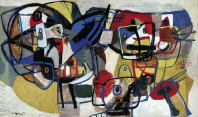Interfaces: A Journal of Medieval European Literatures
ISSN: 2421-5503

The Journal Interfaces opens
an interdisciplinary and multilingual forum for the study of medieval
European literatures. These literatures are broadly conceived as the
products of the interconnected textual cultures which flourished between
Late Antiquity and the Renaissance in a region extending from the North
Atlantic to the Eastern Mediterranean. Interfaces envisages
the study of the textual culture of medieval Europe as situated at the
intersection of a number of modern disciplines, including history,
literature, philology, codicology, philosophy, sociolinguistics, and
theology.
Contributions are invited which cross
linguistic or disciplinary boundaries in the recognition that the
vitality of medieval texts in present-day scholarship and culture
demands a space not confined by single philologies, national research
traditions, confessions, or disciplinary canons. Interfaces
strives to combine methodological questioning of hermeneutic and
didactic practices with the opening up of new common themes, new
connections between literatures, and new transdisciplinary
conceptualisations of the modern understanding of medieval literatures,
including regional and global challenges to claims of European unity.
It is the ambition of Interfaces
to publish the best new scholarship which will contribute to a
redefining of how the medieval textual heritage Europe is read,
researched, taught and disseminated in the 21st century.
European medieval civilization – of which Greek, Hebrew, Slavonic, and
Arabic textual cultures form an integral but often neglected part – will
continue to be an important source of cultural identity in a globalised
world and the global perspectives of the 21st century impel
us to ask new questions of the medieval past. The changing forms and
technologies of literature and historical writing in the present also
urges us to engage with pre-modern writing in new ways. The texts
transmitted to us from the Middle Ages and how we read them are a
crucial site for negotiating the relationship between modernity and the
past.
Interfaces will promote new types of
high quality scholarship as well as make the case for the historical,
intellectual, and aesthetic value of the literatures of a broadly
conceived medieval Europe.
Biblical Creatures: The Animal as an Object of Interpretation in Pre-Modern Christian and Jewish Hermeneutic Traditions
This issue of Interfaces
explores the question of how Jewish and Christian authors in pre-modern
Latin Europe thought and wrote about some of the animals mentioned in
the Bible. To them, thinking about animals was a way of thinking about
what it means to be human, to perceive the world, and to worship God and
his creation. Animals' nature, animals' actions and animals' virtues or
shortcomings were used as symbols and metaphors for describing human
behavior, human desires, human abilities and disabilities, and positive
or negative inclinations or traits of character.
Both Christian
and Jewish medieval and early modern scholars wondered about how they
could possibly delve into the deeper layers of meaning they assumed any
textual or extra-textual animal to convey. Not surprisingly, they often
had to deal with the fact that a specific animal was of interest to
members of both religious communities. A comparison between Jewish and
Christian ways of reading and interpreting biblical passages featuring
animals shows what the two hermeneutic traditions had in common, what
separated them, and how they influenced each other, depending on the
historical context in which the authors worked.
The papers in this issue of Interfaces
cover a wide range of animal species, such as the dove, the stag, the
unicorn, the elephant, the crocodile, the lion, the hyena, the raven,
the hare, and the dog as medieval and early modern authors and
illuminators portrayed and interpreted them. Since several themes come
up in more than one paper concerning different kinds of animals, this
issue groups its papers in three sections. These sections deal with
divine creatures (mediators between humankind and God, symbols for the
human believer, agents of heaven); exotic creatures (animals in
different parts of the world, encounters between humans and animals in
past times, animals with extraordinary appearances and properties); and
social creatures (transgressive and pious animals, animals used to
demonstrate obedience or to facilitate transgression, animals as symbols
for conflict or cooperation).
Table of Contents
Full Issue
|
|
Astrid Lembke, Beatrice Trînca, Elke Koch,
Julia Weitbrecht, David Rotman, Johannes
Traulsen, Oren Roman, Andreas Kraß, Sara
Offenberg, Bernd Roling, Kenneth Stow
|
193 p.
|
Individual Articles
2015
Lucio Fontana, Concetto Spaziale, 1968: idropittura su tela, 73 x 92 cm
cat. gen. 68 B 16
© Fondazione Lucio Fontana, Milano
2016
Mark Rothko, Untitled (Violet, Black, Orange, Yellow on White and Red), 1949: oil on canvas, 81 ½ x 66 inches (207 x 167.6 cm)
Solomon R. Guggenheim Museum, New York: Gift, Elaine and Werner Dannheisser and The Dannheisser Foundation, 1978: 78.2461
Alberto Burri, Sacco L.A., 1953: burlap and acrylic on canvas, 39 5/16 x 33 7/8 inches (101 x 87 cm), inv. 5337
© Fondazione Palazzo Albizzini Collezione Burri, Città di Castello – by SIAE 2016
2017
Max Ernst,
Fleur Bleue, non datée, vers 1964: huile sur bois, 21,2 x 27 cm
Inv.
Fondation des Treilles 990.110 - Photographie par Jacqueline Hyde (1922-2013) – by SIAE 2017











 Stumble It!
Stumble It!

No comments:
Post a Comment